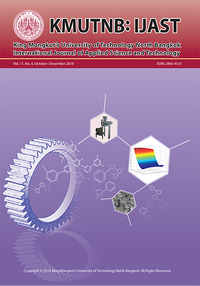Essential Oil Composition and in Vitro Anti-aging Potential of Elettariopsis wandokthong Rhizome
Main Article Content
Abstract
The objectives of this study were to determine the essential oil composition and the anti-aging potential of essential oil and extracts from E. wandokthong rhizome. The essential oil was obtained by hydro-distillation of the fresh rhizome and its composition was identified by Gas Chromatography coupled to Mass Spectrometry system (GC-MS). Five major components, α-gurjunene (22.31%), alloaromadendrene (18.20%), 4-allyloxyimino-2-carene (5.83%), fenchyl acetate (5.44%), and γ-cadinene (5.19%), were identified in E. wandokthong essential oil. Moreover, the fresh rhizome and hydrodistillation residue were each extracted with ethanol, 50% ethanol-water, and water. The anti-aging potential of the essential oil and of the different extracts was evaluated for their total phenolic content, antioxidant, anti-tyrosinase, and keratinocyte proliferation promoting activities. The E. wandokthong rhizome extracts were about 5 times higher activity than that of the essential oil in all assays. The 50% ethanol-water extract provided the highest efficacy in all assays. Moreover, the antioxidant, anti-tyrosinase, and keratinocyte proliferation promoting activities of the hydrodistillation residue extracts were reduced about 2 times compared to those of the fresh rhizome. The results indicated that E. wandokthong rhizome essential oil and extracts have potential to use as fragrant and active ingredient in cosmetic products.
Article Details
References
[2] S. Afoulous, H. Ferhout, E. G. Raoelison, A. Valentin, B. Moukarzel, F. Couderc, and J. Bouajila, “Chemical composition and anticancer, antiinflammatory, antioxidant and antimalarial activities of leaves essential oil of Cedrelopsis grevei,” Food and Chemical Toxicology, vol. 56, pp. 352–362, Jun. 2013.
[3] G. Iscan, N. Kirimer, M. Kurkcuoglu, K. H. Baser, and F. Demirci, “Antimicrobial screening of Mentha piperita essential oils,” Journal of Agricultural and Food Chemistry, vol. 50, pp. 3943–3946, May 2002.
[4] I. Jallali, Y. Zaouali, I. Missaoui, A. Smeoui, C. Abdelly, and R. Ksouri, “Variability of antioxidant and antibacterial effects of essential oils and acetonic extracts of two edible halophytes: Crithmum maritimum L. and Inula crithmosmall L.,” Food Chemistry, vol. 145, pp. 1031–1038, Feb. 2014.
[5] M. D. Sokovic, J. Vukojevic, P. D. Marin, D. D. Brkic, V. Vajs, and L. J. van Griensven, “Chemical composition of essential oils of Thymus and Mentha species and their antifungal activities,” Molecules, vol. 14, no. 1, pp. 238–249, Jan. 2009.
[6] G. Buchbauer, “The detailed analysis of essential oils leads to the understanding of their properties,” Perfumer Flavorist, vol. 25, pp. 64–67, Mar. 2000.
[7] R. Pooma and S. Suddee, Thai Plant Names Tem Smitinand. Bangkok: Office of the Forest Herbarium, Department of National Parks, Wildlife and Plant Conservation, 2014 (in Thai).
[8] C. Picheansoonthon and P. Yupparach, “Further study on the Elettariopsis baker (Zingiberaceae) in Thailand−a new species and a new record,” Taiwania, vol. 55, pp. 335–341, Jan. 2010.
[9] V. Chairgulprasert, S. Prasertsongskun, S. Junpra-ob, and M. Sangjun, “Chemical constituents of the essential oil, antioxidant and antibacterial activities from Elettariopsis curtisii Baker,” Songklanakarin Journal of Science and Technology, vol. 30, pp. 591–596, Aug. 2008.
[10] H. Ibrahim, D. R. Syamsir, A. N. Aziz, K. Awang, M. A. Nor Azah, M. Mastura, and R. M. Ali, “Essential oils of Elettariopsis curtisii (Zingiberaceae) and their antimicrobial activities,” Journal of Essential Oil Research, vol. 21, pp. 464–466, Dec. 2011.
[11] K. C. Wong, Y. Sivasothy, and P. L. Boey, “Essential oils of Elettariopsis slahmong C. K. Lim,” Journal of Essential Oil Research, vol. 18, pp. 203–205, Nov. 2011.
[12] O. Theanphong, T. Phadungcharoen, T. Jenjittikul, and W. Mingvanish, “Essential oil composition of Elettariopsis wandokthong Picheans. & Yupparach rhizome from Thailand,” Bulletin of health science and technology, vol. 14, pp. 30–35, Jul. 2016.
[13] W. Vichit and N. Saewan, “Antioxidant activities and cytotoxicity of Thai pigmented rice,” International Journal of Pharmaceutical Sciences and Research, vol. 7, pp. 329–334, Jul. 2015.
[14] W. Vichit and N. Saewan, “Effect of germination on antioxidant, anti-inflammatory and keratinocyte proliferation of rice,” International Food Research Journal, vol. 23, pp. 2006–2015, Feb. 2016.
[15] N. Saewan, S. Koysomboon, and K. Chantrapromma, “Anti-tyrosinase and anti-cancer activities of flavonoids from Blumea balsamifera DC,” Journal of Medicinal Plants Research, vol. 5, pp. 1018–1025, Mar. 2011.
[16] N. Alam, K. N. Yoon, K. R. Lee, J. S. Lee, and T. S. Lee, “Phenolic compounds concentration and appraisal of antioxidant and antityrosinase activities from the fruiting bodies of Pleurotus eryngii,” Advances in Environmental Biology, vol. 5, pp. 1104–1113, May 2011.
[17] M. Działo, J. Mierziak, U. Korzun, M. Preisner, J. Szopa, and A. Kulma, “The potential of plant phenolics in prevention and therapy of skin disorders,” International Journal of Molecular Sciences, vol. 17, pp. 1–41, Feb. 2016.


